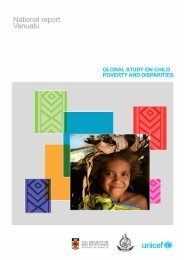A Strategic Assessment of the Children's Services Industry
A Strategic Assessment of the Children's Services Industry
A Strategic Assessment of the Children's Services Industry
- No tags were found...
You also want an ePaper? Increase the reach of your titles
YUMPU automatically turns print PDFs into web optimized ePapers that Google loves.
STRATEGIC ASSESSMENT OF THE CHILDREN’S SERVICES INDUSTRYreasons as <strong>the</strong>ir major reason. Work-related reasons were cited as <strong>the</strong> primary reason forusing care by 78 per cent <strong>of</strong> those with children in long day care, 80 per cent <strong>of</strong> family daycare users and 93 per cent <strong>of</strong> parents <strong>of</strong> children in outside school hours care (DEEWR,2008a). Parents combine formal services with informal care being provided by parents,relatives (especially grandparents), friends or neighbours. Use <strong>of</strong> informal care has beendeclining in recent years, perhaps reflecting <strong>the</strong> growing participation <strong>of</strong> older women (some<strong>of</strong> whom are grandparents) in <strong>the</strong> labour force.From an economic perspective, demand and supply and <strong>the</strong> interrelationships between <strong>the</strong>mare critical elements <strong>of</strong> <strong>the</strong> market for early childhood services (Willer, et al., 1991, Kalb andLee, 2007). Supply is reflected in <strong>the</strong> quantity and characteristics <strong>of</strong> services that providers<strong>of</strong>fer at a given price.5.1 The supply <strong>of</strong> children’s servicesThe total number <strong>of</strong> all funded places, both Commonwealth and State or Territory, in 2006was 861,434 Australia wide (SCRGSP, 2006).Figure 5.2: Supply <strong>of</strong> Children’s <strong>Services</strong> by Type (2006)300,000250,000200,000150,000100,00050,0000Centre‐Based LDC Out <strong>of</strong> School Hours Care Preschools Family Day Care(a) O<strong>the</strong>r care (e) Occasional careSource: SCRGSP, 2008Approximately 92 per cent <strong>of</strong> children using long day care are under 5 years <strong>of</strong> age (DEEWR,2008a) while 84 per cent <strong>of</strong> children attending out <strong>of</strong> school hours services are aged 6 andover (PC, 2008).In terms <strong>of</strong> geographical distribution <strong>of</strong> available children’s services, <strong>the</strong> States <strong>of</strong> New SouthWales and Queensland have both around 27 per cent <strong>of</strong> available places, followed by Victoriaat 22 per cent <strong>of</strong> <strong>the</strong> total.43
















